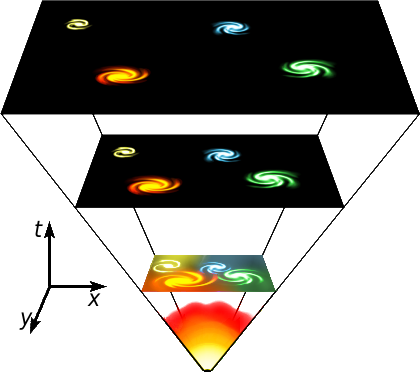Universe as a language trap
Due to our human shortcomings we tend to entangle us with stupid concepts which then get a life of their own. These include not only e.g. irrational numbers but also such peculiarities as 'beginning', 'creation', 'existence', 'god' etc.
There can't be 'the', 'a', 'one' or 'many' in front of universe.
To understand this simple fact you just need to expore it by pinpointing the histories of light perceptions hitting "your world". Such light phenomenons may represent a "distance"* of everything from light traveling at 300,000 km/sec some fractions of a second to Billions of years. Moreover, some of them may be just side by side and with equal relative luminance. With this in mind then start it all over again, i.e. your theoretical mapping of "the Universe".
* If the source has moved or vanished when you perceive its light, then there i no real "distance" to be measured.
to be continued...
Some conventional views later to be commented by Klevius:

In astronomy and cosmology, dark matter is matter that is inferred to exist from gravitational effects on visible matter and gravitational lensing of background radiation, but that neither emits nor scatters light or other electromagnetic radiation (and so cannot be directly detected via optical or radio astronomy).[1] Its existence was hypothesized to account for discrepancies between calculations of the mass of galaxies, clusters of galaxies and the entire universe made through dynamical and general relativistic means, and calculations based on the mass of the visible "luminous" matter these objects contain: stars and the gas and dust of the interstellar and intergalactic medium.
According to observations of structures larger than solar systems, as well as Big Bang cosmology interpreted under the Friedmann equations and the FLRW metric, dark matter accounts for 23% of the mass-energy density of the observable universe. In comparison, ordinary matter accounts for only 4.6% of the mass-energy density of the observable universe, with the remainder being attributable to dark energy.[2][3] From these figures, dark matter constitutes 83%, (23/(23+4.6)), of the matter in the universe, whereas ordinary matter makes up only 17%.
Dark matter was postulated by Fritz Zwicky in 1934 to account for evidence of "missing mass" in the orbital velocities of galaxies in clusters. Subsequently, other observations have indicated the presence of dark matter in the universe; these observations include the rotational speeds of galaxies, gravitational lensing of background objects by galaxy clusters such as the Bullet Cluster, and the temperature distribution of hot gas in galaxies and clusters of galaxies.
Dark matter plays a central role in state-of-the-art modeling of structure formation and galaxy evolution, and has measurable effects on the anisotropies observed in the cosmic microwave background. All these lines of evidence suggest that galaxies, clusters of galaxies, and the universe as a whole contain far more matter than that which interacts with electromagnetic radiation. The largest part of dark matter, which does not interact with electromagnetic radiation, is not only "dark" but also, by definition, utterly transparent.[4]
As important as dark matter is believed to be in the cosmos, direct evidence of its existence and a concrete understanding of its nature have remained elusive. Though the theory of dark matter remains the most widely accepted theory to explain the anomalies in observed galactic rotation, some alternative theoretical approaches have been developed which broadly fall into the categories of modified gravitational laws, and quantum gravitational laws








